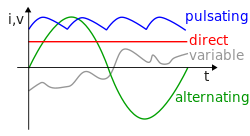Direct current (DC) is a fundamental concept in the field of electricity, representing a consistent flow of electric charge in one direction. This unidirectional flow of electrons through a circuit is essential for various electronic devices and power systems. The concept of DC is rooted in the motion of electric charges from a point of high potential to a point of low potential, driven by voltage sources like batteries or generators[1]. The motion of electrons in a DC circuit creates an electric field that allows for the transfer of energy from one point to another, enabling the operation of devices such as motors, light bulbs, and heaters[1].
In the realm of electrical engineering, DC is distinguished from alternating current (AC) by its steady flow in a single direction. While AC reverses direction periodically, DC maintains a constant path from positive to negative terminals within a circuit[3]. This consistency in electron flow makes DC particularly suitable for applications requiring stable and predictable power delivery, such as in battery-powered devices or certain industrial processes.
The practical implications of DC extend beyond simple circuits to more complex systems involving resistors, capacitors, and inductors. Understanding the behavior of DC in these components is crucial for designing efficient and reliable electrical systems. Ohm’s law, which relates voltage, current, and resistance in a circuit, forms the basis for analyzing and calculating various parameters in DC circuits[2].
Moreover, the efficiency and safety considerations associated with DC circuits are paramount. Proper handling of electrical equipment, adherence to safety protocols to prevent electrical shocks, and awareness of potential hazards like short circuits are essential aspects when working with DC systems[2]. Additionally, the efficiency of power transfer in a circuit can be optimized by understanding factors like source resistance and maximum power transfer conditions[2].
The historical context of DC is rich with developments and innovations that have shaped the modern electrical landscape. The “War of the Currents” in the late 19th century between proponents of AC and DC systems highlighted the competition and technological advancements that ultimately led to the widespread adoption of AC power transmission for long-distance energy transfer[5]. Despite this historical rivalry, DC continues to play a crucial role in specific applications where its characteristics are advantageous.
In conclusion, direct current serves as a cornerstone in electrical engineering and technology, providing a stable and reliable means of transmitting power for diverse applications. Its simplicity, predictability, and efficiency make it indispensable in powering everyday devices and complex industrial systems alike. Understanding the principles and applications of DC is essential for engineers, technicians, and enthusiasts working in the field of electricity.
- Direct current – Wikipedia
Direct current (DC) is the one-directional flow of electric charge. It flows in a constant direction, unlike alternating current (AC). DC has various applications, from charging batteries to powering electronic systems and motors. It can be converted from AC using a rectifier and vice versa using an inverter. The Wikipedia page provides a detailed overview of direct current, its characteristics, generation, and uses. - High-voltage direct current – Wikipedia
This page discusses the use of high-voltage direct current (HVDC) for electric power transmission. It covers topics such as the technology behind HVDC, its advantages, applications, and advancements in ultrahigh-voltage direct current (UHVDC) transmission. The article also mentions specific HVDC transmission projects and their impact on power systems. - Electric current – Wikipedia
While not directly related to the term “Direct current,” this page provides a comprehensive overview of electric current, including its measurement, effects, and various related concepts such as resistive heating, Ohm’s law, and the behavior of electric currents in different materials.
Citations:
[1] https://en.wikipedia.org/wiki/Direct_current
[2] https://en.wikipedia.org/wiki/Direct_Currents
[3] https://en.wikipedia.org/wiki/High-voltage_direct_current
[4] https://en.wikipedia.org/wiki/Electric_current
This article needs additional citations for verification. (June 2009) |
Direct current (DC) is one-directional flow of electric charge. An electrochemical cell is a prime example of DC power. Direct current may flow through a conductor such as a wire, but can also flow through semiconductors, insulators, or even through a vacuum as in electron or ion beams. The electric current flows in a constant direction, distinguishing it from alternating current (AC). A term formerly used for this type of current was galvanic current.

The abbreviations AC and DC are often used to mean simply alternating and direct, as when they modify current or voltage.
Direct current may be converted from an alternating current supply by use of a rectifier, which contains electronic elements (usually) or electromechanical elements (historically) that allow current to flow only in one direction. Direct current may be converted into alternating current via an inverter.
Direct current has many uses, from the charging of batteries to large power supplies for electronic systems, motors, and more. Very large quantities of electrical energy provided via direct-current are used in smelting of aluminum and other electrochemical processes. It is also used for some railways, especially in urban areas. High-voltage direct current is used to transmit large amounts of power from remote generation sites or to interconnect alternating current power grids.